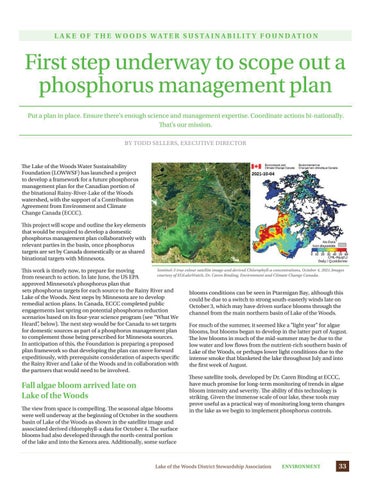L A K E O F T H E W O O D S WAT E R S U S TA I N A B I L I T Y F O U N D AT I O N
First step underway to scope out a phosphorus management plan Put a plan in place. Ensure there's enough science and management expertise. Coordinate actions bi-nationally. That’s our mission. BY TODD SELLERS, EXECUTIVE DIRECTOR
The Lake of the Woods Water Sustainability Foundation (LOWWSF) has launched a project to develop a framework for a future phosphorus management plan for the Canadian portion of the binational Rainy-River-Lake of the Woods watershed, with the support of a Contribution Agreement from Environment and Climate Change Canada (ECCC). This project will scope and outline the key elements that would be required to develop a domestic phosphorus management plan collaboratively with relevant parties in the basin, once phosphorus targets are set by Canada domestically or as shared binational targets with Minnesota. Sentinel-3 true colour satellite image and derived Chlorophyll-a concentrations, October 4, 2021.Images This work is timely now, to prepare for moving courtesy of EOLakeWatch, Dr. Caren Binding, Environment and Climate Change Canada. from research to action. In late June, the US EPA approved Minnesota’s phosphorus plan that sets phosphorus targets for each source to the Rainy River and blooms conditions can be seen in Ptarmigan Bay, although this Lake of the Woods. Next steps by Minnesota are to develop could be due to a switch to strong south-easterly winds late on remedial action plans. In Canada, ECCC completed public October 3, which may have driven surface blooms through the engagements last spring on potential phosphorus reduction channel from the main northern basin of Lake of the Woods. scenarios based on its four-year science program (see “What We Heard”, below). The next step would be for Canada to set targets For much of the summer, it seemed like a "light year" for algae for domestic sources as part of a phosphorus management plan blooms, but blooms began to develop in the latter part of August. to complement those being prescribed for Minnesota sources. The low blooms in much of the mid-summer may be due to the In anticipation of this, the Foundation is preparing a proposed low water and low flows from the nutrient-rich southern basin of plan framework so that developing the plan can move forward Lake of the Woods, or perhaps lower light conditions due to the expeditiously, with prerequisite consideration of aspects specific intense smoke that blanketed the lake throughout July and into the Rainy River and Lake of the Woods and in collaboration with the first week of August. the partners that would need to be involved. These satellite tools, developed by Dr. Caren Binding at ECCC, have much promise for long-term monitoring of trends in algae Fall algae bloom arrived late on bloom intensity and severity. The ability of this technology is Lake of the Woods striking. Given the immense scale of our lake, these tools may prove useful as a practical way of monitoring long term changes The view from space is compelling. The seasonal algae blooms in the lake as we begin to implement phosphorus controls. were well underway at the beginning of October in the southern basin of Lake of the Woods as shown in the satellite image and associated derived chlorophyll-a data for October 4. The surface blooms had also developed through the north-central portion of the lake and into the Kenora area. Additionally, some surface
Lake of the Woods District Stewardship Association Environment
33




















